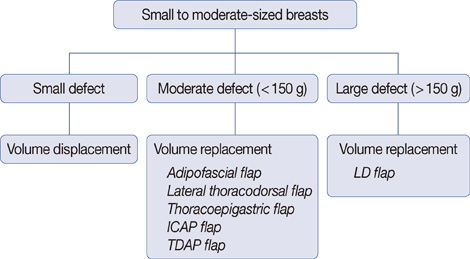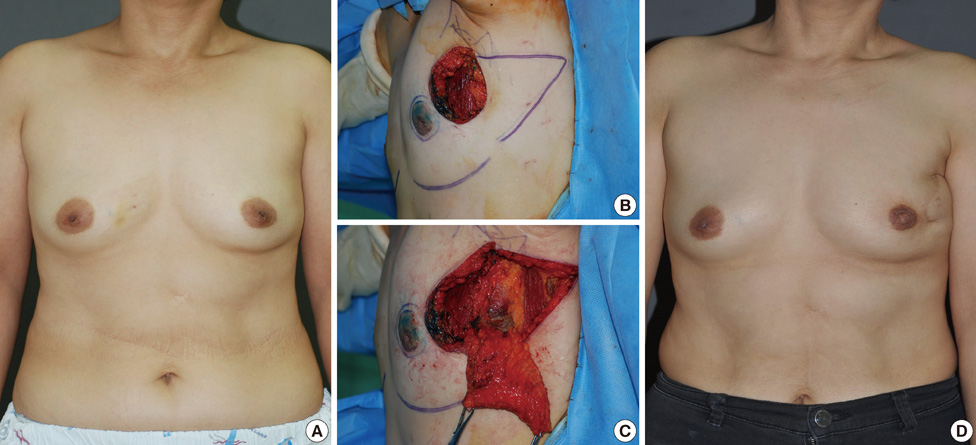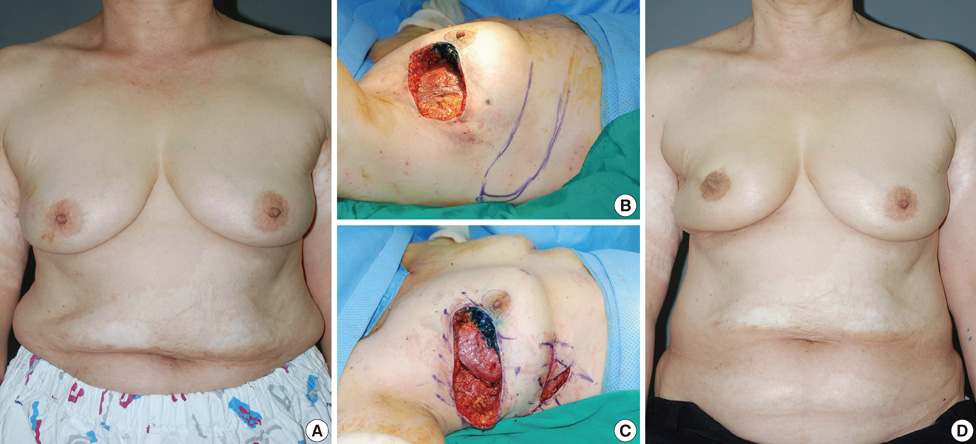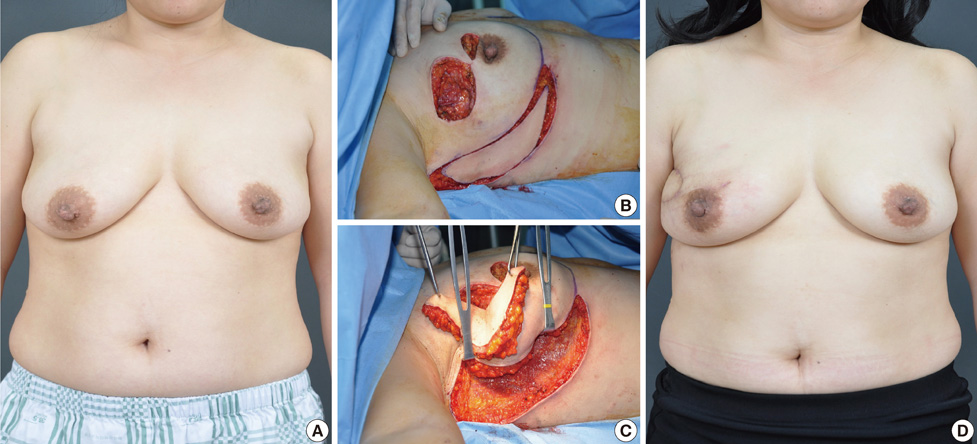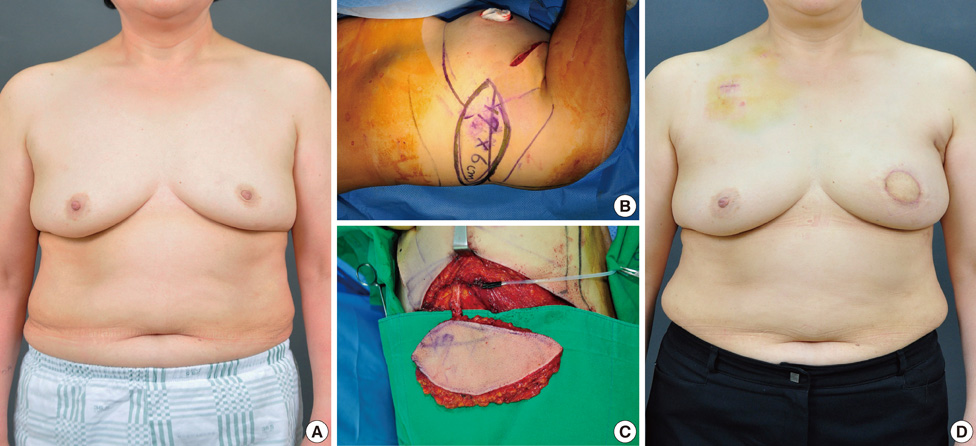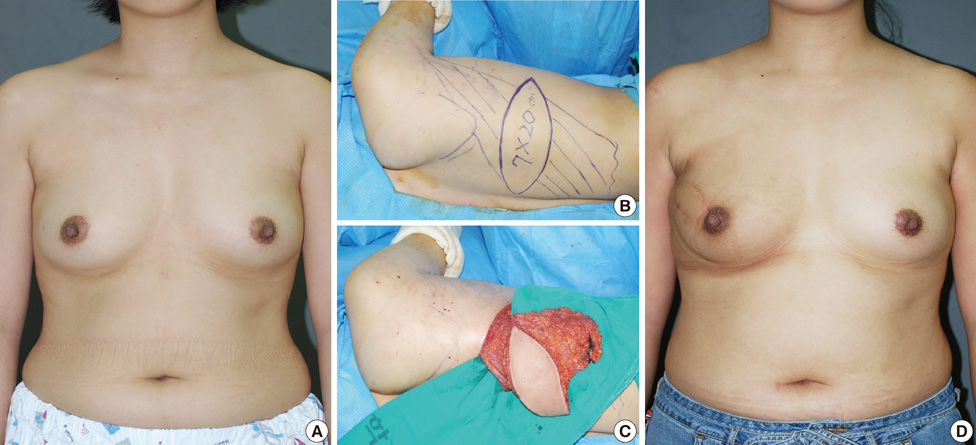J Breast Cancer.
2012 Mar;15(1):7-14. 10.4048/jbc.2012.15.1.7.
Surgical Techniques for Personalized Oncoplastic Surgery in Breast Cancer Patients with Small- to Moderate-Sized Breasts (Part 2): Volume Replacement
- Affiliations
-
- 1Department of Plastic and Reconstructive Surgery, Kyungpook National University School of Medicine, Daegu, Korea.
- 2Department of Surgery, Kyungpook National University School of Medicine, Daegu, Korea. phy123@knu.ac.kr
- KMID: 2286468
- DOI: http://doi.org/10.4048/jbc.2012.15.1.7
Abstract
- Oncoplastic breast surgery has become a popular choice of treatment for breast reconstruction after mastectomy. There are two different techniques in oncoplastic surgery depending on the volume of the excised breast tissue. One is the volume displacement procedure, which combines resection with a variety of different breast-reshaping and breast-reduction techniques; the other is the volume replacement procedure in which the volume of excised breast tissue is replaced with autologous tissue. In this study, current authors performed various volume replacement techniques based on the weight of the excised tumor and its margin of resection. We used a latissimus dorsi myocutaneous flap for cases in which the resection mass was greater than 150 g, and for cases in which the resection mass was less than 150 g, we used a regional flap, such as a lateral thoracodorsal flap, a thoracoepigastric flap, or perforator flaps, such as an intercostal artery perforator flap or a thoracodorsal artery perforator flap. In the patients with small to moderate-sized breasts, when a postoperative deformity is expected due to a large-volume tumor resection, the replacement of non-breast tissue is required. Many of whom have small breasts, oncoplastic volume replacement techniques in breast-conserving surgery allow an extensive tumor excision without concern of compromising the cosmetic outcome and can be reliable and useful techniques with satisfactory aesthetic results.
MeSH Terms
Figure
Reference
-
1. Yang JD, Bae SG, Chung HY, Cho BC, Park HY, Jung JH. The usefulness of oncoplastic volume displacement techniques in the superiorly located breast cancers for Korean patients with small to moderate-sized breasts. Ann Plast Surg. 2011. 67:474–480.
Article2. Munhoz AM, Montag E, Arruda E, Brasil JA, Aldrighi JM, Gemperli R, et al. Immediate conservative breast surgery reconstruction with perforator flaps: new challenges in the era of partial mastectomy reconstruction? Breast. 2011. 20:233–240.
Article3. Yang JD, Lee JW, Kim WW, Jung JH, Park HY. Oncoplastic surgical techniques for personalized breast conserving surgery in breast cancer patient with small to moderate sized breast. J Breast Cancer. 2011. 14:253–261.
Article4. Losken A, Hamdi M. Partial breast reconstruction: current perspectives. Plast Reconstr Surg. 2009. 124:722–736.
Article5. Hamdi M, Wolfli J, Van Landuyt K. Partial mastectomy reconstruction. Clin Plast Surg. 2007. 34:51–62.
Article6. Beahm EK. Nahabedian M, editor. Timing and key considerations in reconstruction for breast-conserving therapy. Oncoplastic Surgery of the Breast. 2009. Philadelphia: Saunders Elsevier;23–46.
Article7. Kronowitz SJ, Feledy JA, Hunt KK, Kuerer HM, Youssef A, Koutz CA, et al. Determining the optimal approach to breast reconstruction after partial mastectomy. Plast Reconstr Surg. 2006. 117:1–11.
Article8. Munhoz AM, Montag E, Arruda E, Aldrighi CM, Filassi JR, Piato JR, et al. Immediate reconstruction following breast-conserving surgery: management of the positive surgical margins and influence on secondary reconstruction. Breast. 2009. 18:47–54.
Article9. Kijima Y, Yoshinaka H, Funasako Y, Kaneko K, Hirata M, Ishigami S, et al. Immediate reconstruction using thoracodorsal adipofascial flap after partial mastectomy. Breast. 2009. 18:126–129.
Article10. Kijima Y, Yoshinaka H, Owaki T, Funasako Y, Aikou T. Immediate reconstruction using inframammary adipofascial flap of the anterior rectus sheath after partial mastectomy. Am J Surg. 2007. 193:789–791.
Article11. Holmström H, Lossing C. The lateral thoracodorsal flap in breast reconstruction. Plast Reconstr Surg. 1986. 77:933–943.
Article12. Levine JL, Reddy PP, Allen RJ. Nahabedian M, editor. Lateral thoracic flaps in breast reconstruction. Oncoplastic Surgery of the Breast. 2009. Philadelphia: Saunders Elsevier;83–92.
Article13. Uemura T. Superior epigastric artery perforator flap: preliminary report. Plast Reconstr Surg. 2007. 120:1e–5e.
Article14. Huemer GM. Fitzal F, Schrenk P, editors. Partial mastectomy: breast reconstruction with the pedicled thoracoepigastric flap. Oncoplastic Breast Surgery: A Guide to Clinical Practice. 2010. Vienna: Springer;127–132.15. Hamdi M, Van Landuyt K, de Frene B, Roche N, Blondeel P, Monstrey S. The versatility of the inter-costal artery perforator (ICAP) flaps. J Plast Reconstr Aesthet Surg. 2006. 59:644–652.
Article16. Khoobehi K, Allen RJ, Montegut WJ. Thoracodorsal artery perforator flap for reconstruction. South Med J. 1996. 89:Suppl 10. S110.
Article17. Hamdi M, Salgarello M, Barone-Adesi L, Van Landuyt K. Use of the thoracodorsal artery perforator (TDAP) flap with implant in breast reconstruction. Ann Plast Surg. 2008. 61:143–146.
Article18. Maxwell GP. Iginio Tansini and the origin of the latissimus dorsi musculocutaneous flap. Plast Reconstr Surg. 1980. 65:686–692.
Article19. Munhoz AM, Montag E, Fels KW, Arruda EG, Sturtz GP, Aldrighi C, et al. Outcome analysis of breast-conservation surgery and immediate latissimus dorsi flap reconstruction in patients with T1 to T2 breast cancer. Plast Reconstr Surg. 2005. 116:741–752.
Article20. Daltrey I, Thomson H, Hussien M, Krishna K, Rayter Z, Winters ZE. Randomized clinical trial of the effect of quilting latissimus dorsi flap donor site on seroma formation. Br J Surg. 2006. 93:825–830.
Article21. Weinrach JC, Cronin ED, Smith BK, Collins DR Jr, Cohen BE. Preventing seroma in the latissimus dorsi flap donor site with fibrin sealant. Ann Plast Surg. 2004. 53:12–16.
Article22. Cho HW, Lew DH, Tark KC. Effect of fibrin sealant in extended lattisimus dorsi flap donor site: retrospective study. J Korean Soc Plast Reconstr Surg. 2008. 35:267–272.23. Chang DW, Youssef A, Cha S, Reece GP. Autologous breast reconstruction with the extended latissimus dorsi flap. Plast Reconstr Surg. 2002. 110:751–759.
Article24. Hoch D, Benditte-Klepetko H, Bartsch R, Gösseringer N, Deutinger M. Fitzal F, Schrenk P, editors. Breast reconstruction with the latissimus dorsi muscle flap. Oncoplastic Breast Surgery: A Guide to Clinical Practice. 2010. Vienna: Springer;157–164.
- Full Text Links
- Actions
-
Cited
- CITED
-
- Close
- Share
- Similar articles
-
- Surgical Techniques for Personalized Oncoplastic Surgery in Breast Cancer Patients with Small- to Moderate-Sized Breasts (Part 1): Volume Displacement
- Oncoplastic Surgical Techniques for Personalized Breast Conserving Surgery in Breast Cancer Patient with Small to Moderate Sized Breast
- Usefulness of Oncoplastic Volume Replacement Techniques after Breast Conserving Surgery in Small to Moderate-sized Breasts
- Partial Breast Reconstruction Using Various Oncoplastic Techniques for Centrally Located Breast Cancer
- Follow-Up after Volume Replacement Using Acellular Dermal Matrix in Oncoplastic Breast-Conserving Surgery

